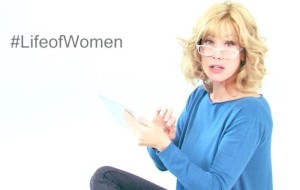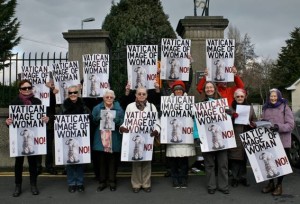“Women’s Consultation Group”
Last week two colleagues and I went to the Pontifical Council for Culture to meet with a top secretary to share about our working group in Rome and to learn more about the “Women’s Consultation Group” of the Council. Our 1.5 hour meeting, in Italian, was very friendly and open. The official we met with was quite pleased with the work that the Council does with women and happy to share. He serves as the facilitator of the Women’s Consultation Group.
 As you will recall, the Council for Culture hosted several gatherings on the topic of “Women’s Cultures” early in 2015, notably the “Life of Women” campaign to the great befuddlement of the media and most outside the Vatican. WOC initiated several call to actions on social media to counter the non-ironic request of the Council to share (in one minute, for one week): “who you are, what you do, what you think about your being a woman, your strengths, your difficulties, your body, and your spiritual life.”
As you will recall, the Council for Culture hosted several gatherings on the topic of “Women’s Cultures” early in 2015, notably the “Life of Women” campaign to the great befuddlement of the media and most outside the Vatican. WOC initiated several call to actions on social media to counter the non-ironic request of the Council to share (in one minute, for one week): “who you are, what you do, what you think about your being a woman, your strengths, your difficulties, your body, and your spiritual life.”
These questions came from a “Women’s Consultation Group,” which the official we met with explained began while preparing for the year’s theme on women. The organizers within the Council, and particularly Cardinal Ravasi, had the idea to consult some women on this topic and invited a group within Italy to share their expertise and thoughts. This is a frustrating point for many as there was no formal or apparent process for who was invited or not.
After the Plenary session (here is my write up about it) at the Teatro Argentina in Rome and following meeting, the Council decided to make the women’s group a stable consultive commission, meeting approximately three times a year, if possible. The group is now about 30 women, most who live in Italy (to keep costs low, he said), and some who are abroad and are called for advice on specific topics or themes via Skype. The group has met once since the Plenary, and will meet again in December.
These women are “advisors,” and as my colleague said, “advisors don’t have to be asked to advise.” The “extra”-curial nature of the group is clear, and an obvious reminder of the continued lack of systemic or institutional agency of Catholic women. However, the official shared that some of the controversial output of the Council were the decisions of the women’s group, including the Man Ray image used on the Council’s website, and the choice of actor for their campaign video.
He shared that there is great interest in this Consultative group, and the Council receives many requests from outside the Curia for more information about the group. When asked if this model could be used in other Councils in Rome, he said that within the Curia there is not much interest.
Interestingly, the official noted that Catholic women from the US “targeted” the Council for Culture, for what he explained as accusing the Council of “always showing the same image of women as victims or mothers.” Similarly, there has been criticism that the women’s names are not listed on their website, to which the official shared that it is hard to maintain because of the changes in the group and in attendance.
What I found most interesting about our meeting was when the Monsignor shared his thoughts on women leaving parishes as “una fuga.” Reflecting on his own sister’s criticism of the Church, he said the Church must answer the question of why women are leaving parishes and this is why it is so important to listen to women today. The model we have now for women does not work and so we have to create new models, he said.
The official gave us each a copy of the Council’s quarterly booklet, “Culture e Fede” published with essays in English, Spanish, French, and Italian. I was surprised to read several pointed critiques of the documents of the Council and consultative group in the publication. In particular, a reflection from Prof. Edward J. Alam, suggested the “philosophical and theological and historical poverty” of the western-centric outlining document, as well as the “fundamentally flawed assumptions in the text,” written without great discussion.
“…On page 17, “[I]t is not a question of bringing about a revolution against tradition,” revealed what the burning issues really was: the ordination of women to the ministerial priesthood. This was confirmed to me in the many informal discussions I had with participants outside the formal meetings. I wish there had been an emphasis of the priesthood of all believers, which both men and women participate in through their baptisms, and a more serious focus on those profound truths such as “women were the first believers, the first witnesses,” but these fundamental facts, to my dismay were dismissed in the text as mere “rhetoric and cliches.”
And a contribution from Ulla Gudmondson, Ambassador of Sweden to the Holy See (2008-2013):
“Isn’t it time for the Catholic Church to apply once again, as as the Second Vatican Council, the twin methods of aggiornamento, absorbing process in the secular world, and ressourcement, digging deep in its own rich tradition, to make way for the free and full participation of both women and men, as creative human beings, at all levels of Church life?”
To my delight, Ulla also quotes Pippi Longstocking: “Whoever is very strong must also be very kind.”
Overall, I was impressed with the time and space this official gave our small delegation, and with his familiarity of many of the critiques of his office and efforts. As opposed to being detained (listen at 45:32) outside the Vatican, I’ll take it.

